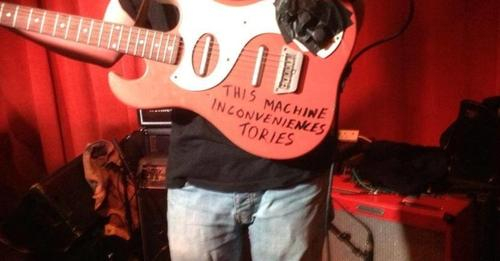What's the point of art?

What purpose do the arts serve today? The arts – Music, literature, painting, sculpture, dance etc. – represent vibrant aspects of human culture. They don’t provide us with food or have any obvious use value but without them we would cease to be human beings in any meaningful sense. We are the only animals to have developed an artistic culture.
The arts form part of the superstructure of society. They arose as an expression of social consciousness and have evolved intimately connected with economic and social developments. But why have the arts evolved into a sophisticated and vital part of our culture? Here, I reflect only on the visual arts and music in an attempt to examine what exactly their significance or use value is.
Artisans assuaging the gods
At the very beginning of human development, those very early drawings/paintings on rocks, of hunting scenes and portraits of wild animals, as well as music, as an accompaniment to dance, were the first expressions of human creativity. They came about in response to a deep psychological need for reassurance, as aids in overcoming our ancestors’ fears and their attempts to assuage the gods (i.e. the forces of nature). In this sense they certainly did have a use value, even if not a tangible one.

Over time, they became increasingly ritualised. Artistic expression became wholly integrated into and part of the social fabric of the tribe, clan or people. At this time, individuals were not designated as ‘artists’ as ‘dancers’ or ‘musicians’, they were simply ordinary members of the group who took on creative tasks. Only later, when society began to produce a surplus of food, and could thus feed ‘non-essential producers’, was the group able to afford to carry individuals such as religious leaders or artists.
For a considerable time, artists (painters and musicians) were treated as mere artisans, as tradesmen, not very different from cobblers, weavers or metal workers. Only with the beginning of the Renaissance did individual artists begin to emerge and achieve special recognition. Artistic skills gained new value and the most skilful and creative of the artists were given due prominence. But still at this time, artists and musicians were obliged to work within a certain ritualistic framework, rooted in a hegemonic religion (whether Muslim or Christian) and within a fixed social hierarchy.
Individualisation and commodification
During the Renaissance, individual artists fought for and began to win increased freedoms of expression and a gradual release from strict religious and social constraints and developed their own individual creativity. This period also saw the dawn of art for itself, in the sense of works of art being no longer viewed as part of a ritual tradition but as aesthetic commodities in their own right. The culmination of this new perception of art would become abstractionism. By definition it offers no message beyond merely aesthetic pleasure or irritation.

The individualisation of the arts went in parallel with its commodification. A price was put on creative works and they were increasingly commissioned and collected by wealthy individuals, rather than by religious institutions. Once the arts’ essential ritualistic role had been eroded, they began to fulfil different purposes. And certainly in Europe, with the severing of that umbilical cord to ritual went the blurring and disappearance of separate cultural identities.
In our modern world of electronic communications, with large global movements of people and cross-cultural fertilisation, individual and separate cultures are being largely eradicated or subsumed into a global culture. This development has been accompanied by an almost complete absence of constraint, censorship or prohibitions.
What have these recent developments meant for the arts, both in terms of function and their place in our cultural life? What role do they play in today’s society and what do we expect from them?
Entertainment and enjoyment
First and foremost, I would argue, that we demand enjoyment, entertainment, and a cathartic experience from the arts. We may also relish a challenge, but that challenge has to incorporate pleasure – otherwise why would we subject ourselves to non-pleasurable or painful experiences?
For the general public the arts certainly do provide entertainment and enjoyment, even if largely of a soporific and passive consumerist nature. Painting and sculpture have today become somewhat marginalised, catering for a small number of (usually wealthy) afficionados. Although there is still a flourishing movement of amateurs alongside professional artists who create largely for their own pleasure – taking part in artistic activity as a practitioner can be rewarding on a purely spiritual level. And lavishly curated exhibitions of great artists of the past, usually accompanied by much media hype, still draw quite large audiences.
Music, on the other hand, has become a truly mass phenomenon. More so than the other traditional arts, music has undergone perhaps the most dramatic change. Traditional, ritualistic and religious music as well as genuine folk music have almost completely disappeared. In an age of secularism and of mass, electronic distribution, musical production has become almost completely commercialised, driven and dominated by large corporations who own rights and distribution networks.
Why do we still listen to music today and what do we seek from it? In its earliest incarnation music was very much a rhythmic sound made on rudimentary instruments. This became an accompaniment to dance and later song, serving as a socially cohesive force, binding groups together. With the continuing development and increasingly sophisticated of instrumentation and then the invention of notation, musical expression evolved radically.
Since the turn of the 19th century we began to divide musical expression arbitrarily into categories, e.g. classical, jazz or popular etc., such separation, though, serves more to confuse than enlighten. All music – for practitioners as well as audiences – has similar aims: to provide relaxation and to entertain.
Particularly, in our world today, I think, though, that practitioners (musicians and artists) will view/listen to musical works with rather different eyes and ears to non-practitioners. Practitioners will look for and obtain satisfaction largely from discovering innovation and challenges to the traditional, whereas non-practitioners (largely passive recipients or amateurs) will simply expect pleasure.
Clearly, the most popular music globally has become that distributed by the big recording and distribution companies, largely in the form of songs and dance numbers and aimed very much at a market in the younger age-range.
The failure of classical music
So-called classical music has entered a critical phase. The era of classical can be said, with one or two exceptions, to have ended by the turn of the 19th- 20th centuries, certainly in its traditional form. We continue to have live performances and recordings from the classical canon but contemporary works categorised as ‘classical’ are few and far between, and obtain minimal airing. This, I would argue, is largely because contemporary composers in that tradition, i.e. classically trained, have failed to find a language that is rooted in the past but which adequately addresses contemporary aural and ‘spiritual’ needs.
So it is largely non-melodic, using few recognisable and catchy tunes. It fails to plumb emotional depths or offer relaxing and enjoyable tonal experiences. Is this perhaps because virtually all possible combinations of melodic and tuneful composition have been exhausted by previous generations? Or is such tuneful and melodic composition in classical form inappropriate for our times? Popular music, too, is rarely genuinely innovative and largely recycles traditional melodic forms.
I can understand that composers, other than jobbing ones or those seeking primarily commercial success would find it frustrating and meaningless to simply repeat compositional forms fully explored by previous generations. They will continually seek new ways of using musical language. The question is: are they able to transform musical composition and innovate while still providing the enjoyment and entertainment audiences in their majority seek? There is perhaps a key contradiction between the needs of most listeners and creators, because, as I say above, the former will be looking primarily for relaxation and enjoyment, while the latter will be looking for new ways of expressing their musical ideas.
Can music convey messages?
A central question when talking about the influence of music – ignoring for a moment the setting of texts to music – is can it convey a message? Music can certainly convey or engender a multitude of emotions, from sad to happy, contemplative to rousing, as well as beautiful and tender. Some pieces of music are said to be full of humanity, but can a piece of music really turn us into a better person, help our humanity unfold? Can it make us more loving and less belligerent?
Those are difficult questions and probably insoluble. As with most other cultural activities, music today is divorced from ritual and is no longer a necessary socially centripetal force. Music on its own can convey no concrete message, but accompanied by lyrics it can, of course, just as the visual arts can convey messages, besides offering aesthetic and visual pleasure,
The pianist, Andras Schiff, recently said that Beethoven’s works ‘carry a humanitarian and spiritual message’ – but can music alone express humanitarianism or communicate a spiritual message? I would love to believe it could but remain sceptical. Many Nazis adored those classical composers deemed to be great humanitarians: Beethoven, Bach, Schubert and Schumann for example. Did it change those Nazis, give them a spiritually beneficial message?
Music has certainly often been used to encourage bellicosity and rouse people to war and as an accompaniment to war, but I can think of no example where it has been used to rouse people to peace. Even Beethoven’s famous 9th symphony with its setting of Schiller’s Ode to Joy and its appeal for social harmony fails on that score:
Thy magic bind again
What vogueish sword has divided
Beggars will be nobles' brothers
Where thy gentle wing abides
This symphony has rarely, if ever, been able to engender true harmony and fraternity.
Once photography arrived on the scene in a big way towards the close of the 19th century, that traditional role for the visual arts – namely the depiction of events or portraiture and still lives as elements of historical record keeping – became redundant. Although portraits, still lives and landscapes etc. are still being painted, they are no longer vital as records of reality. Such works will, though, still be purchased by collectors in order to possess something individually crafted and unique. For the practitioners, both professional and amateur, artistic activity will continue to provide satisfaction and pleasure.
So, to return to my opening question, what purpose do the arts serve today? On the one hand, they serve the same function that they always have – giving pleasure and providing spiritual nourishment but in a very different way to that which they did in their original form. On the other hand, although there are certainly no longer defined parameters for the arts, both artists and their works have been largely commodified.

by Chad McCail
Capitalism has expropriated the arts very much for its own profit-making purposes. But in the ongoing struggle for cultural hegemony, the arts can and do play a vital role. They are also weapons in this struggle, but if they are only used and seen as weapons, they will cease to be art and will be deprived of their unique humanitarian essence.

John Green
John Green is a journalist and broadcaster. He has authored and edited several books and anthologies on a wide range of subjects including political biographies, labour history, poetry, natural history and environmental affairs.
